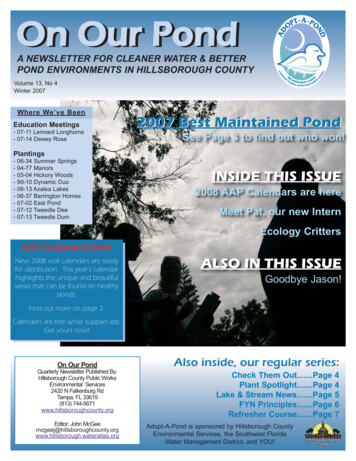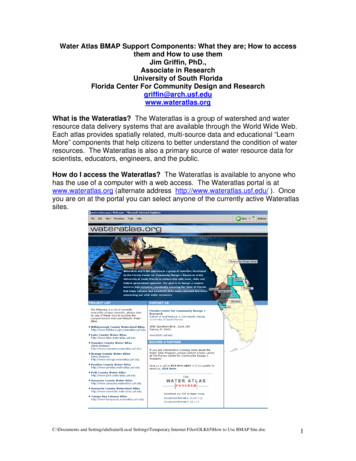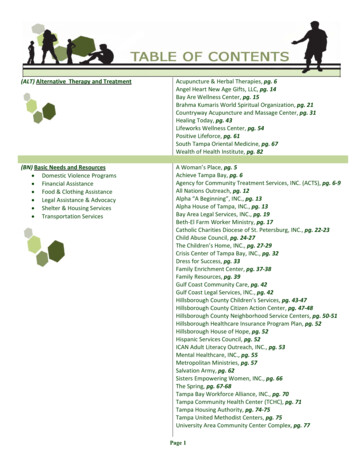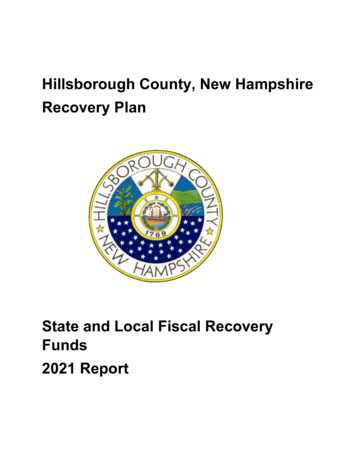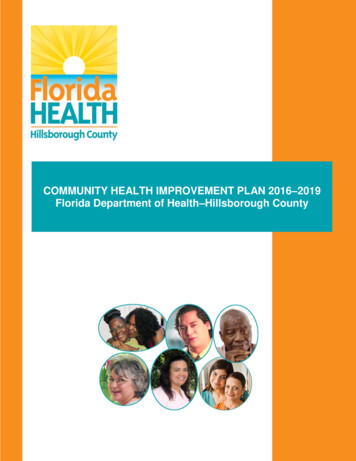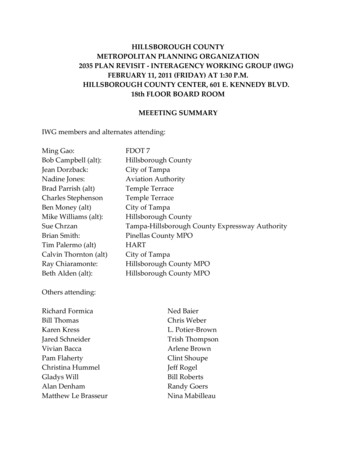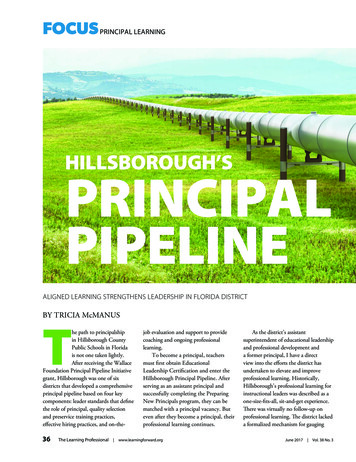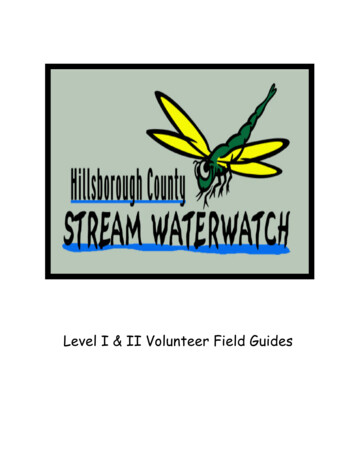
Transcription
ACKNOWLEDGMENTSThis manual draws on the experience of many outstanding citizen monitoring , stewardship andeducation programs. Hillsborough County Stream-Waterwatch gratefully acknowledges thefollowing organizations for their advice and use of materials:City of Tampa Advanced Wastewater Treatment PlantEPA Office of WaterFlorida Department of Environmental ProtectionGeorgia Adopt-A-StreamHillsborough River Greenways Task ForceHillsborough Community CollegeHillsborough County Public Works Stormwater Management DivisionHillsborough County Environmental Protection CommissionSave our Streams, Izaak Walton League of AmericaThe preparation of this manual was supported through a grant from the Florida Game and FreshWater Fish Commission’s Advisory Council on Environmental Education and the SouthwestFlorida Water Management District. The project is a joint effort by the County of Hillsboroughand Hillsborough Community College.2
LEVEL I FIELD GUIDETABLE OF CONTENTSPageIntroduction4I.Identify a Stream Segment to Adopt5II.Name Your Project5III.Conduct a Watershed Walk5IV.Visual Survey9V.Litter Pick up10VI.Send Results11AppendicesUnderstanding Your Watershed14Land Use and Water Quality16Glossary of Stream Related Terms19Think Safety!21Who to Call22Soil Classification23Stream Flow28Unusual Colors and Odors in Waters36Evaluation of Stream Conditions37Forms403
INTRODUCTIONHillsborough County Stream-Waterwatch is a program developed by HillsboroughCommunity College and the Hillsborough County Department of Public Works StormwaterManagement Division. The program was originally funded by a grant from the Florida Gameand Freshwater Commission’s Advisory Council on Environmental Education. The programcurrently receives funding from the Southwest Florida Water Management District and isdesigned to promote citizen involvement in learning about and protecting streams, rivers, andlakes. Stream-Waterwatch gives volunteers the tools to understand and then start protecting theirwater resources. It's a unique "hands-on" approach that brings citizens and government togetherto manage and protect our water resources.This manual describes how to start a Stream-Waterwatch project including how to find astream segment to adopt, and how to conduct a visual assessment and watershed walk. Thismanual covers Stream-Waterwatch Level I activities. Levels II and III involve biologicalmonitoring, chemical testing, and/or habitat enhancement activities, in addition to Level Iactivities. Training workshops are required for Level I and Level II biological monitoring andchemical testing.LEVEL ILevel I is the starting point for new volunteers and StreamWaterwatch projects. Volunteers regularly evaluate a streamsegment, pick up litter, and report results to HillsboroughCounty Stream-Waterwatch. Stream-Waterwatch projects arelong term protection efforts. Volunteers commit to adopt astream or river section for at least one year. Follow steps Ithrough XI outlined in this manual to complete a one year Stream-Waterwatch project.Level I activities include:····finding a stream site/segment for adoptionconducting an initial watershed walkvisual assessments of water quality and physical habitat at one site four times ayearregular litter pick upsThese activities help protect streams because:A watershed walk provides a record of potential impacts to water quality such as pipe effluent,eroding stream banks, illegal dumps and surrounding land uses. Regular visual assessments atone site can provide important clues to the overall health of your stream or river. Documenting4
changes in water quality and habitat are important to understanding water qualitytrends. Volunteers evaluate water color, clarity, streambank and stream bed habitat. Litterpicks ups remove hazards and pollutants to aquatic life as well as improve an area forrecreation. And finally, sharing the results of your project with others helps everyoneunderstand that these are our streams, and we all have to work to protect them.Volunteers help improve water quality, one stream at a time, by regularly recordingstream conditions, notifying authorities if problems arise, removing litter, and telling others inthe community about their findings. Understanding local water quality conditions is the first steptoward protecting our water resources.I. IDENTIFY A STREAM SEGMENT TO ADOPTFind a stream (or river) segment to adopt. Many groups adopt between a ½ and 1 milesegment of stream. When choosing a stream, think of your goals. Do you want to learn moreabout a section of stream that flows by your school or home? Volunteers may want to study thequality of the local drinking water source. Comparing the effect of land use on water quality canbe interesting (sample upstream and downstream of a farm, an urban area, etc.). Also,topographical or county maps are good sources of water resource information.Generally, however, follow these guidelines:Select a stream meaningful to you or your group.Select a stream that has easy, safe and legal access.Select a project that you can have fun with!II. NAME YOUR PROJECTThink of a name for your group or project. Your project name will help identify you as anestablished effort to protect a local stream. As an example, the Environmental TechnologyStudents at HCC adopted a site on English Creek and call their project the "English Creek WaterQuality Team."III. CONDUCT A WATERSHED WALK(based in part on work done by Georgia Adopt-A-Stream)Start your Level I project with a Watershed Walk. A watershed walk involves creating arecord of land uses and potential impacts on your adopted stream. Runoff from different land5
uses, pipes discharging into the water, natural springs flowing into the stream, highwaycrossings, and other impacts can all have significant effects on a stream. A thick stand of forestadjacent to a stream may filter pollutants running over land, provide shade, and hold soil in place.A highway or a parking lot near the stream may collect oil and gasoline that runs into the streamwhen it rains. A pipe may discharge wastes from a nearby city or industry, or a stormwater pipemay directly route runoff into a stream.What Is a Watershed?Figure 1 Cross section of a watershedA watershed includes the entire area drained by a certain stream or river. Hills andmountains determine which direction water flows, a drop of rain falling on one side of a hill mayeventually find it's way to your stream. If the drop of rain falls on the other side of the hill, it willfollow a different path to a different stream or river (Figure 1). Looking at a topographical mapwill help you determine what area makes up your watershed.Water draining into your stream may carry with it soil, fertilizer from lawns and fields,oil and gas from parking lots and roads, or anything the water comes in contact with. Streamsdrain water from land in the surrounding area, so every activity on the land can have an impacton your stream. A natural area of vegetation next to the stream helps keep these pollutants out of6
the water. See the appendices for more detail.Equipment Listtopo map of area surrounding streamPen or pencilBoots/waders or old tennis shoesCamerawatershed walk survey and summary formWHERE TO STARTBefore the watershed walk:Read the watershed information in the Appendix.Read "Think Safety" in the Appendix.Obtain the topographical map of your area. Find the stream you plan to walk or canoe andmark the beginning and end points of the study segment, usually ½ to 1 mile. Study themap before the walk and note important features along the way. The location of crossingroads, feeder streams, electric power lines, or dams can be used for navigation and asreference points. Also, note the surrounding land area--will you expect to find urban,residential, or rural areas or a combination?Review the Watershed Walk Survey and Summary Form.You must have permission of landowners if you walk across private property. The countyplanning commission office will have a list of property owners along the chosen sectionof stream. The office will have tax maps showing all property lines and the lot number foreach property. Make a list of each lot number, then look up the property in the tax booksto obtain a full name and address for the owners. You can prepare an announcement totake or mail to all the property owners. Tell them who you are, what your group is doing,and why you are doing it. Make sure to provide a phone number of someone to contact incase they have any questions. If possible, hand deliver the announcements. This gives youthe opportunity to introduce yourself to the property owners, and provide them withadditional information. If they are not at home, leave the announcement on the outside ofthe mailbox. You'll likely discover that many of the property owners will be veryinterested in learning more or in helping in the effort. Youmay want to include a Stream Water-Watch brochure or flyer with the announcementIf you canoe your section, you may not need to contact all the property owners. Please just usecommon sense, don't walk across private land and be sure not to leave anything behind.7
In urban areas, it may be not be practical to contact all landowners adjacent to a streamsegment. In this case, your watershed walk may actually be a drive. Visit several sites where thestream crosses a road. Use caution when getting in and out of your car, especially on bridges.Other vehicles may not see you.During the walk:Assign tasks to the team members such as taking notes, marking map, and wading in thestream.Walk or canoe a length of stream to assess what may be influencing your adopted section.Start at the upstream portion. As you proceed downstream, mark the significant featureson the map (you may want to cover the map with plastic and use a wax pencil). Thesefeatures may include the location of erosion, runoff, livestock wading, sewer pipes, stormdrains or land use along the stream that is likely to cause problems. Use your bestjudgement as to what may be significant. If unsure, make a note and ask later. Make asketch of the details, showing North and approximate distances along the stream.Complete the Watershed Walk Survey Form.After the walk:On the basis of the Watershed Walk Survey Form, notes and map details, you should beable to do the Watershed Summary. The Summary should reflect the actual conditions inthe stream at the time of observation.Select one or more sites for quarterly visual assessments. Place the location of theselection(s) on the stream map.Select Site(s) for Quarterly Visual AssessmentsConsider these criteria to select one or more sites to conduct quarterly visual assessments:1. Physical Accessibility: There is ease reaching the stream site. The stream site is easy and safeto reach.2. Legal Accessibility: There are NO trespass problems or safety problems.8
IV. VISUAL SURVEYA great deal of information can be gained by simply observing your stream at sitesselected during your watershed walk. The idea is to record a set of observations every time youvisit your stream site(s). In this way, both short and long term changes can be documented. Visityour stream site(s) quarterly or once every three months. Set dates now so your group canplan accordingly. For example, plan to do a visual survey the last Saturday in February, May,August and November.Equipment List:clipboardpencilVisual Survey Formtape measureyardstickthermometerOptional:tree or shrub identification guidecameraleaf presssunscreeninsect repellenthip waders or bootsrubber ball or orangeFollow these directions to complete the Visual Survey Form:1. Look at the amount and speed of the water. How high is the stream? (hint-look for high watermarks on the streambank) Is the water flowing slower or faster compared with your last visit?Use your best judgement to estimate high, normal, or low flow. Stream flow can be calculatedflow by measuring the cross section of a stream segment and then taking a velocity measurement(see appendix on Stream Flow for details). Record.2. Observe where the water is flowing, if there are rocky areas where the water moves quickly,these areas are called riffles. They provide good habitat for macro invertebrates and fish. Doesthe water slow down in some spots and form pools? Pools provide a place for fish to rest andfeed. Estimate the number of pools and riffles in your section of stream. Record.3. Look at the stream depth and width. Riffles will be shallow, pools will be deeper. Measure orestimate the depth at the center of the stream and the width of an average section of the stream.Record.9
4. Water color and odor are associated with specific conditions--some naturally occurring andsome influenced by human activity. Brown or muddy water may indicate sedimentation in yourstream. In Florida many streams are clear, but naturally tea-colored due to decaying leaves andplants. Very green water may indicate excessive algae growing in the water. Learn to recognize"normal" water colors and odors in your stream. Refer to the "Evaluation of Stream Conditions"chart in the Appendix. Record the colors and odors that best describe your stream site.5. Fish and aquatic insects need certain conditions in a stream to survive. One critical condition iscalled habitat--the availability of good places to search for food, hide from predators, andreproduce. The bed of the stream can tell you a lot about habitat available for aquatic life. Rocksand vegetation provide good habitat while sediment covers the places to hide and lay eggs. UseChart B in the Appendix to rank the stream bed and sediment deposits and record on streamassessment survey form. For a quantitative method, see "Soil Classification" in the Appendix.6. Stream banks function as a part of the whole stream system. Streambank stability describeshow well soil and vegetation are held in place. If stream banks are unstable, soil will erode intothe stream during a rain. The amount and type of vegetation on stream banks is also veryimportant. Vegetation holds soil in place and prevents erosion on stream banks. Trees and largeshrubs can provide shade for the stream, many types of fish and insects need cooler water tosurvive. You can record both left and right stream banks (facing downstream) or the generalcondition.7. Algae are simple plants without roots or leaves. They are naturally present in streams, riversand lakes. Algae are found growing on rocks or logs, floating in clumps, or in long strands. Theymay be green, brown, or reddish. Sometimes, however, algae grow out of control when excessivenutrients are present. Nutrients like nitrogen and phosphorus are found in waste water, animalwastes, and fertilizers. Fertilizers from lawns, golf courses, and cropland may run into streams.The nutrients are food for algae, and the more they get, the more they multiply. Excessive algaein a stream can cause oxygen levels to drop when algae decompose. Low oxygen levels make itimpossible for fish and other organisms to live. Record the appearance and location of algae.8. Finally, note general observations--did you see any wildlife? Are there human activities in thearea that impact the stream? How about litter? Write down anything about the area that you thinkis important.V. LITTER PICK UPLitter can harm aquatic life. Cans can rust, batteries can leak acid into water, and plasticcan cut or tangle fish or birds. Litter also can impair the recreational use of streams for peopleand is just plain ugly. Regular litter pick ups will help improve the water quality in your stream.Bring a trash bag(s) with you during your quarterly visual surveys and pick up litter. Oneperson may do this while others complete the visual survey. You may want to plan a day to pick10
up litter on your ½ to 1 mile stream segment. If you have large items, talk to the city or countyabout getting some assistance from the public works or fire department. You may want to weargloves to protect your hands from broken glass or sharp objects.VI. SEND RESULTSSend a copy of your Watershed Walk Survey and Summary, your quarterly visual surveyswith the Level I Activity Summary to Hillsborough County Stream-Waterwatch each quarter.You efforts are important, don't keep the results to yourself! Also, we know your group is activeonly when we regularly receive your results.Complete a new Level I Activity Summary each quarter. The Activity Summary is arecord of your group's activities each quarter and for the entire year. Make a copy of the ActivitySummary. Send the copy to Hillsborough County Stream-Waterwatch no later than March 31.June 30, September 30 and December 31. Keep the original for your records.Feel free to send a copy of your results to anyone else interested in the health of yourstream. Your local newspaper may want to run a story about your group and your findings. Yourgroup may want to send your results to everyone in your watershed, including private homes andbusinesses. Public outreach is probably the most important Stream-Waterwatch activity. This isa chance to share with others in the community information about your project, the condition ofyour stream, and your dedication to protecting local water resources. Many groups will beinterested in learning about local streams through an article or presentation.One way to keep the public informed is to make available the water quality results thatyour group finds. This can be accomplished by installing a sign that identifies your group and thesection of stream or river that you’ve adopted. We have signs available for installation at yoursite upon request. By sharing the results of your group’s findings the local community willbecome aware of your group’s efforts and outcomes regarding the water quality in their area.IF YOU WANT TO LEARN MORE ABOUT YOUR STREAM OR IMPROVE THEHABITAT.Consider participating in Stream-Waterwatch Level II or III. Level II involves choosingeither biological monitoring, chemical monitoring, or a habitat improvement project. Youconduct these activities in addition to your Level I project. Level III involves two or more of theLevel II activities, plus Level I participation. You can greatly increase your understanding of thechemical and biological forces at work in your stream or actively improve a section of stream.Flip through the Level II and III manual and see if you are interested. If you are, sign up for aworkshop or contact Stream-Waterwatch for more details.11
FOR QUESTIONS REGARDING STREAM -WATERWATCHErik Garwell, Ph.DChemical Training CoordinatorEmail: stream-waterwatch@juno.comPamela Vergara, Ph.D., P.E.Stream Waterwatch Coordinator1206 N. Park RoadPlant City, FL, 33566(813) 757-2186Email: streamwaterwatch@bellsouth.net12TRAINING CONTACT:
APPENDICES13
UNDERSTANDING YOUR WATERSHED: THE VITAL LINK BETWEEN LANDUSES AND WATER QUALITYby Larry LeBeouf, Save Our StreamsOver the last decade, significant achievements have been made in the protection andenhancement of water quality. However, most of the significant reductions in pollution havecentered around decreasing the amount of toxics from factory discharge pipes through waterconservation, better technology and stricter legislation. However, our rivers continue to bepolluted even with these improvements due to runoff pollution from the land. When you want toprotect a particular river from pollution you cannot simply consider the pollution problemsimmediately in your river. You must ask yourself the question, where did this pollution comefrom? In order to learn where the pollution originates from, so that you can undertake solutions,you must be familiar with your watershed. By defining the area of your watershed, mapping it toshow possible pollution sources, and reporting these sources to local and state authorities you canfinally put an end to the pollution that has claimed so many of our streams and rivers.What Is A Watershed?It comes in many shapes and sizes. It may be nearly flat or hilly or rocky; it may even bein your own backyard. What is it? It's a watershed, an area of land from which water drains into agiven point, usually a larger body of water. Smaller watersheds make up larger watersheds,creating a series of watersheds, known as a drainage basin, which may encompass several states.What happens in these smaller watersheds, whether good or bad, affects the larger watershedsdownstream. The Mississippi River watershed, for example, drains about 1,243,000 square miles,carrying agricultural pesticides, city runoff and other pollutants into the Gulf of Mexico.Defining Your Watershed:Defining the area which makes up your watershed is important because all land uses in aparticular watershed affect the water quality of streams that drain the land. Since water runsdownhill, the lay of the land determines the size of your watershed. By locating the area slopingdown to your stream you can determine what land practices may affect your stream's waterquality. Topographic maps from your local office of the U.S. Geological Survey (USGS) can beused to map out your watershed's drainage pattern and to pinpoint possible pollution problems.For example, if your watershed consists primarily of farms, your stream may suffer frompesticide and fertilizer pollution when it rains. If factories are also present in your watershed,toxic pollution may be contaminating your river. If large, paved areas, such as shopping malls ordense housing developments, exist in your watershed, oil from parking lots and urban runoff mayharm stream life.There are two types of pollution sources in your watershed: point sources and nonpoint14
sources. Point sources consist of pollutants which originate from a clearly identifiable source andmove through a conduit, such as a factory discharge pipe. Nonpoint sources consist of runofffrom the land, which may contain pesticides, fertilizers, metals, manure, road salt and otherpollutants. Sources of these nonpoint pollutants include farms, lawns, paved urban areas,construction sites, timber harvesting operations, landfills and home septic systems.Mapping Your Watershed:Mapping your watershed will aid you in determining what possible pollution sources maybe affecting your river. To understand what pollution problems are present in your watershed andare affecting the water quality of your river, draw a sketch of your watershed using USGStopographic maps to determine the size of your watershed, then identify locations of differentland uses and point and nonpoint sources of pollution. This will help determine where pollutionsources are located and what potential pollution problems exist. If you notice a pollution problemin your stream, you will be able to pinpoint possible causes using your watershed map.Improving Water Quality In Your WatershedRainfall and other water that does not evaporate or soak into the soil becomes surfacerunoff and drains into various bodies of water. If a great deal of rain falls over a short period oftime, however, it might cut gullies and carry off topsoil vital to farms, ranches and crops. Excesswater may also cause flooding, which damages property and highways and can even destroyspawning beds for fish. High sediment levels in streams can clog stream channels, smother fishand destroy aquatic life.Nonpoint sources of pollution can be abated by implementing soil and water conservationpractices and adding flood prevention measures can reduce damage. For instance, grass, trees,bushes, shrubs and even weeds can help hold soil in place. Planting stream banks with stabilizingvegetation can reduce problems caused by erosion and slow down flood waters. Application ofBest Management Practices (BMPs) such as terraces, strip-cropping and improved pasturepractices, can be used on farms to make more water soak into the soil and to reduce the potentialfor erosion.15
LAND USE AND WATER QUALITYUrbanizationThe urbanization of land concentrates people, and the pollutants that result from their lifestyles,in areas that are largely covered with impervious surfaces--buildings, driveways, roads,sidewalks, and parking lots. This combination of people, pollutants, and pavement producesurban runoff that can carry a greater pollutant load than municipal sewage.The amount of pollutants carried in urban runoff with stormwater or snow melt is influenced bytraffic density, littering, fertilizer and pesticide use, construction site practices, animal wastes,soil characteristics, topography of the area, percentage of impervious surfaces, atmosphericdeposition, and amount of precipitation.Pollutants transported in urban storm sewer systems to nearby waters include nutrients, bacteria,litter, soil, toxic chemicals, and organic (oxygen-consuming) materials.Construction sitesConstruction activities can harm nearby waters in three ways. The first occurs when natural landcover is disturbed during excavation and grading operations. Soil stripped of its protectivevegetation can be easily washed into nearby surface waters. Second, stormwater runoff oftencarries materials used on the site, such as oil, grease, paints, glues preservatives, acids, cleaningsolutions, and solvents, into nearby lakes or streams. And third, inadequate planning--failure todesign and construct projects with water quality factors in mind, such as peak runoff and flowrouting--can accelerate runoff.Septic SystemsMany homes are not connected to municipal wastewater treatment systems and rely on septictanks and field lines for sewage treatment. If they are well designed, installed, and maintained,septic systems will safely treat wastewater for 20 to 50 years. Improper design, installation, oroperation of septic systems or holding tanks can lead to pollution of surface or groundwater bybacteria, nutrients, and household toxic chemicals. A recent U.S. Environmental ProtectionAgency (EPA) report stated that most waterborne diseases are probably caused by old or poorlydesigned and operated septic systems.Septic systems use natural decomposition to treat wastes. Holding tanks do not treat wastes, butsimply contain them on site. Both septic systems and holding tanks must be periodically pumpedout or cleaned. Care must be taken in disposing of the materials removed in this cleaning. Solidscleaned out of septic systems can be land-spread since they are partially treated, but continuousspreading on a single site of land should be avoided. Wastes removed from holding tanks needadditional treatment since they generally have not undergone much decomposition.16
CroplandsStormwater and snow melt runoff from croplands can carry sediments, nutrients, bacteria, andorganic contaminants into nearby lakes and streams. Nitrates and pesticides can seep fromagricultural lands and contaminate underlying groundwater supplies. By volume, sediment is thepollutant entering waters in the largest quantity. Cropland erosion is the most significant sourceof sediment. Good water quality and soil erosion management practices by individual landmanagers is the key to stopping valuable soil loss. This also protects water quality by preventingthe movement of sediment and other pollutants from croplands to waters.Livestock OperationsAnimal feedlots are defined as lots and buildings used to confine animals for feeding, breeding,raising, or holding purposes. This definition includes open ranges used for feeding and raisingpoultry, but does not include pastures. Poor or inadequate feedlot management can allowstormwater runoff to carry pollutants from accumulating manure into surface and groundwaters.Feedlots can create significant pollution problems. Pollutants coming from animal feedlotsinclude nutrients, oxygen-demanding materials, and pathogens that may affect humans andanimals. High nitrate levels in groundwater have been associated with improper storage ofanimal manure.FertilizersNitrogen, phosphorus, and potassium are the three primary nutrients applied to crops, gardens,and lawns as fertilizers. Phosphorus and nitrogen entering water bodies in runoff from overfertilized areas can cause nuisance conditions, such as heavy algal blooms and excessive weedgrowth, making lakes unsuitable for swimming, waterskiing, and other uses. The presence ofnitrates in rural well water presents a risk to infants under six months old whose formula isprepared with nitrate-contaminated water. Young infants lack the ability to handle high levels ofnitrate and may develop methemoglobinemia (blue-baby syndrome), a disease impairingthe ability of blood to carry oxygen throughout the body. Studies have indicated that nitrogen infertilizers and manures is a probable source of elevated nitrate concentrations in ruralgroundwater supplies.PesticidesPesticides are used to control undesirable plants or animals. They include herbicides,insecticides, fungicides, and rodenticide. Pesticides are used on agricultural lands, on urban andsuburban lawns and gardens, as aquatic nuisance controls in lakes, and in forest management.Pesticide application can lead to groundwater contamination. Surface waters can be contaminatedby drift from pesticide spraying and by runoff from pesticide-treated soil. Both surface and17
groundwaters are vulnerable to contamination by stormwater runoff flowing from storage,mixing, loading, and spray-tank cleaning areas.Mining ActivitiesMining activities can cause dramatic changes in surrounding watersheds. Lakes, streams, andgroundwater can be polluted by sediment, tailings, dust, chemicals, and wastes from open pit,strip, and underground mines. Regulations to control mining activities have been instituted atboth U.S. Federal and state levels.Forest PracticesWaters in forested areas usually are of very high quality, so pollution, when it does occur, islikely to harm a valuable and relatively sensitive ecosystem. Forestry activities that can transferpollutants from land to water are road construction, clearing land for fire breaks, stacking
Hillsborough County Stream-Waterwatch is a program developed by Hillsborough Community College and the Hillsborough County Department of Public Works Stormwater Management Division. The program was originally funded by a grant from the Florida Game and Freshwater Commission's Advisory Council on Environmental Education. The program
